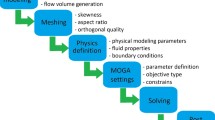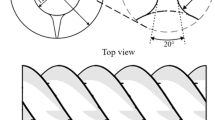Abstract
The cooling performance of a centrifuge was enhanced using a perforated windshield. The windshield spatially separates the rotor and the chamber, reducing turbulence and air resistance. On the other hand, during centrifuge rotation, heat is generated by friction between the internal structure and air. Optimizing the windshield shape and facilitating efficient heat exchange with the chamber wall are essential for cooling the sample container inside the windshield. This study examined the cooling performance of the perforated windshield through analysis and experiment. The effects of the presence, location, and diameter of the perforations were compared using computational fluid dynamics (CFD) simulations and considering temperature and flow characteristics. These results suggest that the perforated windshield enhances the cooling performance of the centrifuge.
Similar content being viewed by others
Abbreviations
- P :
-
Density of fluid
- E :
-
Energy per unit mass
- \(\overrightarrow{U}\) :
-
Velocity of fluid
- p :
-
Pressure
- k eff :
-
Effective conductivity
- T :
-
Temperature
- h j :
-
Chemical species type
- \(\overrightarrow{J_{\!\!\!\!=j}}\) :
-
Diffuse flux
- τ eff :
-
Turbulent stress tensor
- S h :
-
Heat source term
- C p :
-
Heat capacity of the fluid
- ϵ eff :
-
Viscosity of the fluid
- Ω :
-
Rotational angular velocity of each node
- R :
-
The distance of each node from the axis of rotation, or radius
References
C. S. Kim, K. S. Hong and M. K. Kim, Nonlinear robust control of a hydraulic elevator, Control Engineering Practice, 13(6) (2005) 789–803.
D. Rickwood and G. D. Birnie, Introduction: principles and practices of centrifugation, Centrifugal Separations in Molecular and Cell Biology, Butterworth-Heinemann, UK (1978) 1–6.
C. Lin, Y. Chang, K. Liang and C. Hung, Temperature and thermal deformation analysis on scrolls of scroll compressor, Applied Thermal Engineering, 25(11–12) (2005) 1724–1739.
S. S. Kang and S. K. Cho, Thermal deformation and stress analysis of disk brakes by finite element method, Journal of Mechanical Science and Technology, 26(7) (2012) 2133–2137.
T. Zhu, Y. Wang, W. Geng and Q. Li, Rotor air-friction loss and thermal analysis of high-speed rotor for axial flux PM motor, 2021 23rd European Conference on Power Electronics and Applications (EPE’21 ECCE Europe), Ghent, Belgium, (2021) 1–12.
A. Jakobs, E. Gürkal, J. N. Möller, M. G. Löder, C. Laforsch and T. Lueders, A novel approach to extract, purify, and fractionate microplastics from environmental matrices by isopycnic ultracentrifugation, Science of the Total Environment, 857(3) (2023) 1–8.
B. Frank Philip and P. A. Persson, Deformation, heating and melting of solids in high-speed friction, Proceedings of the Royal Society of London. Series A. Mathematical and Physical Sciences, 260(1303) (1961) 433–458.
A. M. Ei-Jummah, R. A. A. A. Hussain, G. E. Andrews and J. E. J. Staggs, Conjugate heat transfer CFD predictions of impingement heat transfer: influence of the number of holes for a constant pitch-to-diameter ratio X/D, Proceedings of the ASME Turbo Expo 2014: Turbine Technical Conference and Exposition, 5(A) (2014) 1–14.
M. E. Nakhchi, J. A. Esfahani and K. C. Kim, Numerical study of turbulent flow inside heat exchangers using perforated louvered strip inserts, International Journal of Heat and Mass Transfer, 148 (2020) 1–10.
T. Y. Lin and S. G. Kandlikar, Heat transfer investigation of air flow in microtubes—part I: effects of heat loss, viscous heating, and axial conduction, J. Heat Transfer, 135(3) (2013) 1–9.
T. W. Kim, The effects of viscous heating considerations on hing speed flow CFD analysis, Journal of Korean Society for Computational Fluids Engineering, 23(3) (2020) 87–94.
J. Pawlicki, D. Glowacki, J. Zwoliński and A. Mościcki, Elastic limit load resource when reaming holes in turbine rotor discs, Engineering Failure Analysis, 113 (2020) 1–10.
S. Vedantam, K. E. Wardle, T. V. Tamhane, V. V. Ranade and J. B. Joshi, CFD simulation of annular centrifugal extractors, International Journal of Chemical Engineering, 2012 (2012) 1–31.
W. Geng, T. Zhu, Y. Zhang, C. Wu, Y. Wang, Q. Li and Z. Zhang, Rotor air friction loss and thermal analysis of IPM rotors for high speed axial-flux machine, IEEE Transactions on Industry Applications, 59(1) (2022) 779–788.
C. A. Montavon, H. Grotjans, I. S. Hamill, H. W. Phillips and I. P. Jones, Mathematical modelling and experimental validation of flow in a cyclone, 5th International Conference on Cyclone Technologies, Warwick, UK (2000) 175–186.
P. I. Kefalas and D. P. Margaris, CFD simulation and experimental verification of the flow field in a centrifugal separator, International Review on Modelling and Simulations, 2(4) (2009) 472–478.
ANSYS, Inc., ANSYS FLUENT 12 Theory Guide, ANSYS, Inc., U.S.A. (2009).
M. H. Lee, C. M. Kim, G. Y. Park, C. H. Choi and C. Y. Park, Grid independence test of computational fluid dynamics model for indoor airflow analysis, Journal of Korean Institute of Architectural Sustainable Environment and Building Systems, 14(2) (2020) 183–194.
T. Yoshida, K. Sato and T. Kondo, Blood-mimicking fluid using glycols aqueous solution and their physical properties, Japanese Journal of Applied Physics, 53(7S) (2014) 1–6.
Acknowledgments
This work was supported by INHA UNIVERSITY Research Grant.
Author information
Authors and Affiliations
Corresponding author
Additional information
Young-Min Kim is a master’s student in the Department of Mechanical Engineering, Inha University. He received his Bachelor of Science degree in 2019 in naval architecture and ocean engineering at Hongik University. His research interests include computational fluid dynamics and design optimization.
Chul-Hee Lee received his Doctor of Philosophy degree in 2006 in mechanical and industrial engineering at the University of Illinois at Urbana-Champaign. He was a chassis research engineer at Hyundai Motor Co. from 1996 to 2002 and a senior research and development engineer at Caterpillar, Inc. (USA), from 2006 to 2007. He is a Professor in the School of Mechanical Engineering, Inha University. His research interests are in the areas of virtual product development by design optimization and FE analysis.
Rights and permissions
About this article
Cite this article
Kim, Y.M., Lee, KH., Chung, SM. et al. Effect of the windshield perforation patterns on the cooling performance in centrifugal separators. J Mech Sci Technol 38, 2475–2483 (2024). https://doi.org/10.1007/s12206-024-0426-0
Received:
Revised:
Accepted:
Published:
Issue Date:
DOI: https://doi.org/10.1007/s12206-024-0426-0




